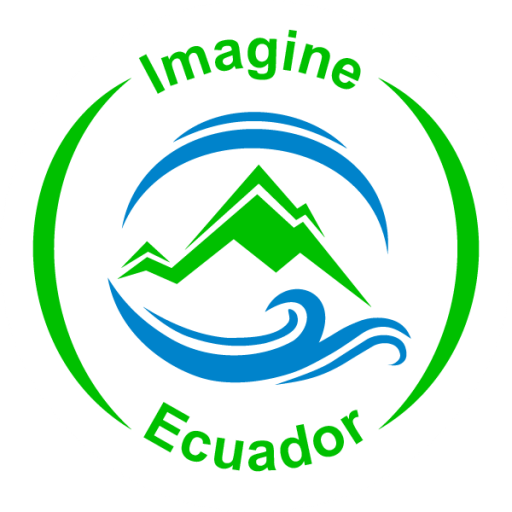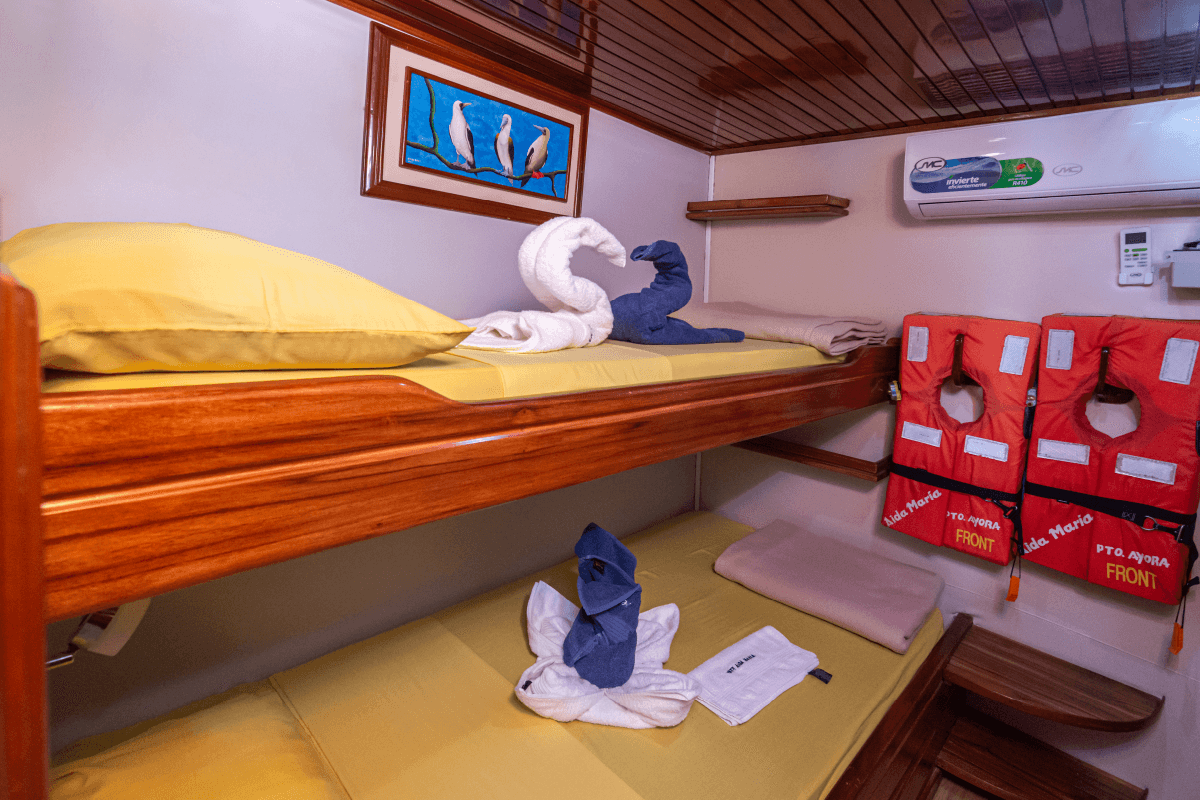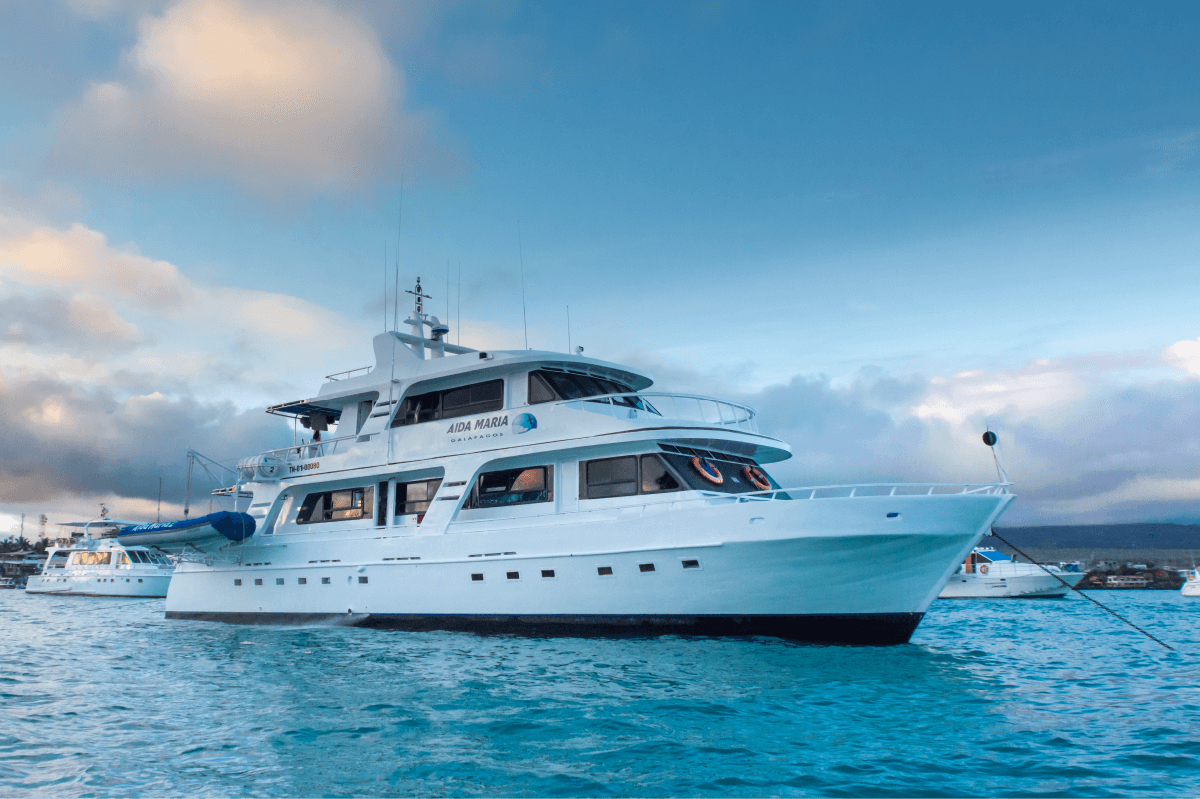MIDRANGE YACHTS
Aida Maria Yacht
Aida Maria Yacht, Galapagos Islands Ecuador, Cruises, Tours. The sixteen passengers Aida Maria offers a great combination of comfort, style and economy for tours in the Galapagos. Each of the eight double cabins has a private bath and hot shower, air conditioning and an ample external deck to enjoy sunny Galapagos days. Started operating in the galapagos in 1997offering cruises around the islands as a charter yacht as well as for individual travelers.
Its design is based in efficiency and comfort with ample social areas and 8 cabins 2 in main deck,2 in upper deck and 2 in solarium providing optimum comfort for your experience exploring the Galapagos. She takes 16 guests in double cabins with private facilities, A/C and hot water and desalinate having unlimited water.
Departure dates for 5 and 8 day cruises starting Sundays and Thursdays.
Specifications:
Category: First Class
Capacity: 16
Dimensions: 21m length / 5 m breadth
Engines: 9 knots / 2 CAT 125 hp each
Electricity: 2 yammer generators 110 v
Fuel Capacity: 1500 gallons/diesel
Water Capacity: 2200 gallons filled by
desalinator at 80gal. per hour
Equipment: Complete navigation and safety equipment, 2
dingies with 16 hp outboard motor.
8-day Galapagos Itinerary “A” (C+D)
| Sunday-Sunday: | ||
| SUN | Am | Baltra Island Arrival in Baltra airport and transfer to the boat. Briefing onboard about the boat and the island. |
| Pm | Santa Cruz Island: Bachas Beach A swimming beach and one of the few remnants of the U.S. World War II presence in the Galápagos. | |
| MON | Am | Genovesa Island: Darwin Bay A coral beach where a 750 mt. trail takes you through more seabird colonies. |
| Pm | Genovesa Island: Prince Phillip’s Steps An extraordinary, steep path leads through a seabird colony full of life, up to cliffs that are 25m high. | |
| TUE | Am | Bartholomew Island Visit the Pinnacle Rock and the white-sand beach: the best area to get photos of Galápagos penguins. |
| Pm | Santiago Island: Sullivan Bay Thelava field has a variety of patterns made by the shapes and textures of trees that once existed there. | |
| Sombrero Chino Island The landing is on a beautiful crescent-shaped beach, home to sea lions and Sally Lightfoot crabs. | ||
| WED | Am | Daphne Island A popular stop for scientists researching the unique qualities of the Galapagos finches. |
| Pm | Santa Cruz Island: Dragon Hill A hypersalinic lagoon frequented by flamingos, stilts, pintail ducks and other species of birds. | |
| THU | Am | Santa Cruz Island: Charles Darwin Station An organisation that provides scientific assistance to ensure the proper preservation of the Galápagos. |
| Pm | Santa Cruz Island: Highlands The highlands are located in the northern part of the island and can reach elevations up to 1500 mt. | |
| FRI | Am | Floreana Island: Post Office Bay A white-sand beach where in the past sailors used to leave and receive their letters in a barrel. |
| Floreana Island: Cormorant Point Cormorant Point offers a trail overlooking a saltwater lagoon that is a favourite of flamingos. | ||
| Pm | ||
| SAT | Am | Española Island: Suárez Point Suárez Point is one of the most outstanding wildlife areas of the archipelago. |
| Pm | Española Island: Gardner Bay Gardner Bay has a magnificent beach with turquoise waters. The bay is home of a large colony of sea lions. | |
| SUN | Am | San Cristobal Island: Leon Dormido This island comprises two rocks which jut out of the ocean and is home to a large colony of sea birds. |
| San Cristobal island-Transfer to the airport | ||
8-day “B” Galapagos Itinerary
| Sunday -Sunday: | ||
| SUN | Am | San Cristobal Island Arrival to airport where your trip will begin. San Cristobal is the first island in the Galapagos that Charles Darwin visited. |
| Pm | San Cristobal Island: Isla Lobos This small island is named after the sea lions that rest and play on its rocky shores | |
| MON | Am | Santa Fe Island A volcanic uplift that hosts a forest of Opuntia and palo santo. Endemic land iguanas are often seen |
| Pm | South Plaza Island South Plaza has one of the largest populations of land iguanas in the Galápagos. | |
| TUE | Am | Santa Cruz Island: Charles Darwin Station An organisation that provides scientific assistance to ensure the proper preservation of the Galápagos. |
| Pm | Santa Cruz Island: El Chato A reserve in the highlands where you have the opportunity to observe the giant tortoise in the wild. | |
| Santa Cruz Island: Highlands The highlands are located in the northern part of the island and can reach elevations up to 1500 mt. | ||
| WED | Am | Isabela Island: Puerto Villamil A small peaceful town with a laid back atmosphere and long white-sand, palm-lined beaches. |
| Pm | Isabela Island: The Wall of Tears Isabela was a penal colony. Prisoners were made build a wall with huge blocks of lava as punishment. | |
| Isabela Island: Tortoise Breeding Station Created to protect animals in their first years of life from the threats of foreign species. | ||
| THU | Am | Isabela Island: Moreno Point Beautiful rocky shores where penguins and shore birds, including blue herons, are usually spotted. |
| Pm | Isabela Island: Elizabeth Bay As enter you the bay, hawks can soar overhear and schools of fish can be seen swimming underneath. | |
| FRI | Am | Isabela Island: Tagus Cove An opportunity to see penguins as well as marine iguanas, Sally Lightfoot crabs and sea lions. |
| Pm | Fernandina Island: Espinosa Point A narrow stretch of land where hundreds of marine iguanas gather largely on black lava rocks. | |
| Isabela Island: Vicente Roca Point The remnants of an ancient volcano form two turquoise coves with a bay protected from ocean swells. | ||
| SAT | Am | Santiago Island: Puerto Egas Puerto Egas, with its black sand beaches, was the site of small salt mining industry in the 1960s. |
| Pm | Rábida Island A bird-watcher’s delight. Species includes Flycatchers, Galapagos Hawks and Brown Pelicans. | |
| SUN | Am | North Seymour Island Explore the rocky coast, passing colonies of blue-footed boobies and magnificent frigatebirds. |
| Baltra island-Transfer to the airport | ||
5 – day Galapagos Itinerary “C”
| Sunday-Thursday: | ||
| SUN | Am | Baltra Island Arrival in Baltra airport and transfer to the boat. Briefing onboard about the boat and the island. |
| Pm | Santa Cruz Island: Bachas Beach A swimming beach and one of the few remnants of the U.S. World War II presence in the Galápagos. | |
| MON | Am | Genovesa Island: Darwin Bay A coral beach where a 750 mt. trail takes you through more seabird colonies. |
| Pm | Genovesa Island: Prince Phillip’s Steps An extraordinary, steep path leads through a seabird colony full of life, up to cliffs that are 25m high. | |
| TUE | Am | Bartholomew Island Visit the Pinnacle Rock and the white-sand beach: the best area to get photos of Galápagos penguins. |
| Pm | Santiago Island: Sullivan Bay Thelava field has a variety of patterns made by the shapes and textures of trees that once existed there | |
| Sombrero Chino Island The landing is on a beautiful crescent-shaped beach, home to sea lions and Sally Lightfoot crabs. | ||
| WED | Am | Daphne Island A popular stop for scientists researching the unique qualities of the Galapagos finches. |
| Pm | Santa Cruz Island: Dragon Hill A hypersalinic lagoon frequented by flamingos, stilts, pintail ducks and other species of birds. | |
| THU | Am | Santa Cruz Island: Charles Darwin Station An organisation that provides scientific assistance to ensure the proper preservation of the Galápagos. |
| Baltra island – Transfer to the airport | ||
4-day Galapagos Itinerary “D”
| Thursday-Sunday: | ||
| THU | Am | Baltra Island Arrival in Baltra airport and transfer to the boat. Briefing onboard about the boat and the island. |
| Pm | Santa Cruz Island: Highlands The highlands are located in the northern part of the island and can reach elevations up to 1500 mt. | |
| FRI | Am | Floreana Island: Post Office Bay A white-sand beach where in the past sailors used to leave and receive their letters in a barrel. |
| Pm | Floreana Island: Cormorant Point Cormorant Point offers a trail overlooking a saltwater lagoon that is a favourite of flamingos. | |
| SAT | Am | Española Island: Suárez Point Suárez Point is one of the most outstanding wildlife areas of the archipelago. |
| Pm | Española Island: Gardner Bay Gardner Bay has a magnificent beach with turquoise waters. The bay is home of a large colony of sea lions. | |
| SUN | Am | San Cristobal Island: Leon Dormido This island comprises two rocks which jut out of the ocean and is home to a large colony of sea birds. |
| San Cristobal – Transfer to the airport | ||
6-day Galapagos Itinerary “E”
| Thursday- Tuesday | ||
| THU | Am | Baltra Island Arrival in Baltra airport and transfer to the boat. Briefing onboard about the boat and the island. |
| Pm | Santa Cruz Island: Highlands The highlands are located in the northern part of the island and can reach elevations up to 1500 mt. | |
| FRI | Am | Floreana Island: Post Office Bay A white-sand beach where in the past sailors used to leave and receive their letters in a barrel. |
| Pm | Floreana Island: Cormorant Point Cormorant Point offers a trail overlooking a saltwater lagoon that is a favourite of flamingos. | |
| SAT | Am | Española Island: Suárez Point Suárez Point is one of the most outstanding wildlife areas of the archipelago. |
| Pm | Española Island: Gardner Bay Gardner Bay has a magnificent beach with turquoise waters. The bay is home of a large colony of sea lions. | |
| SUN | Am | San Cristobal Island: Leon Dormido This island comprises two rocks which jut out of the ocean and is home to a large colony of sea birds. |
| Pm | San Cristobal Island: Isla Lobos This small island is named after the sea lions that rest and play on its rocky shores. | |
| MON | Am | Santa Fe Island A volcanic uplift that hosts a forest of Opuntia and palo santo. Endemic land iguanas are often seen |
| Pm | South Plaza Island South Plaza has one of the largest populations of land iguanas in the Galápagos. | |
| TUE | Am | Santa Cruz Island: Charles Darwin Station An organisation that provides scientific assistance to ensure the proper preservation of the Galápagos. |
| Baltra – Transfer to the airport | ||
6-day Galapagos Itinerary “F”
| Tuesday -Sunday: | ||
| TUE | Am | Baltra Island Arrival in Baltra airport and transfer to the boat. Briefing onboard about the boat and the island. |
| Pm | Santa Cruz Island: El Chato A reserve in the highlands where you have the opportunity to observe the giant tortoise in the wild. | |
| WED | Am | Isabela Island: Puerto Villamil A small peaceful town with a laid back atmosphere and long white-sand, palm-lined beaches. |
| Pm | Isabela Island: The Wall of Tears Isabela was a penal colony. Prisoners were made build a wall with huge blocks of lava as punishment. | |
| Isabela Island: Tortoise Breeding Station Created to protect animals in their first years of life from the threats of foreign species. | ||
| THU | Am | Isabela Island: Moreno Point Beautiful rocky shores where penguins and shore birds, including blue herons, are usually spotted. |
| Pm | Isabela Island: Elizabeth Bay As enter you the bay, hawks can soar overhear and schools of fish can be seen swimming underneath. | |
| FRI | Am | Isabela Island: Tagus Cove An opportunity to see penguins as well as marine iguanas, Sally Lightfoot crabs and sea lions. |
| Pm | Fernandina Island: Espinosa Point A narrow stretch of land where hundreds of marine iguanas gather largely on black lava rocks. | |
| Isabela Island: Vicente Roca Point The remnants of an ancient volcano form two turquoise coves with a bay protected from ocean swells. | ||
| SAT | Am | Santiago Island: Puerto Egas Puerto Egas, with its black sand beaches, was the site of small salt mining industry in the 1960s. |
| Pm | Rábida Island A bird-watcher’s delight. Species includes Flycatchers, Galapagos Hawks and Brown Pelicans. | |
| SUN | Am | North Seymour Island Explore the rocky coast, passing colonies of blue-footed boobies and magnificent frigatebirds. |
| Baltra Island – Transfer to the airport | ||
15-day Galapagos Itinerary “A+B”
| Sunday-Sunday: | ||
| SUN | Am | Baltra Island Arrival in Baltra airport and transfer to the boat. Briefing onboard about the boat and the island. |
| Pm | Santa Cruz Island: Bachas Beach A swimming beach and one of the few remnants of the U.S. World War II presence in the Galápagos. | |
| MON | Am | Genovesa Island: Darwin Bay A coral beach where a 750 mt. trail takes you through more seabird colonies. |
| Pm | Genovesa Island: Prince Phillip’s Steps An extraordinary, steep path leads through a seabird colony full of life, up to cliffs that are 25m high. | |
| TUE | Am | Bartholomew Island Visit the Pinnacle Rock and the white-sand beach: the best area to get photos of Galápagos penguins. |
| Pm | Santiago Island: Sullivan Bay Thelava field has a variety of patterns made by the shapes and textures of trees that once existed there. | |
| Sombrero Chino Island The landing is on a beautiful crescent-shaped beach, home to sea lions and Sally Lightfoot crabs. | ||
| WED | Am | Daphne Island A popular stop for scientists researching the unique qualities of the Galapagos finches. |
| Pm | Santa Cruz Island: Dragon Hill A hypersalinic lagoon frequented by flamingos, stilts, pintail ducks and other species of birds. | |
| THU | Am | Santa Cruz Island: Charles Darwin Station An organisation that provides scientific assistance to ensure the proper preservation of the Galápagos. |
| Pm | Santa Cruz Island: Highlands The highlands are located in the northern part of the island and can reach elevations up to 1500 mt. | |
| FRI | Am | Floreana Island: Post Office Bay A white-sand beach where in the past sailors used to leave and receive their letters in a barrel. |
| Pm | Floreana Island: Cormorant Point Cormorant Point offers a trail overlooking a saltwater lagoon that is a favourite of flamingos. | |
| SAT | Am | Española Island: Suárez Point Suárez Point is one of the most outstanding wildlife areas of the archipelago. |
| Pm | Española Island: Gardner Bay Gardner Bay has a magnificent beach with turquoise waters. The bay is home of a large colony of sea lions. | |
| SUN | Am | San Cristobal Island: Leon Dormido This island comprises two rocks which jut out of the ocean and is home to a large colony of sea birds. |
| Pm | San Cristobal Island: Isla Lobos This small island is named after the sea lions that rest and play on its rocky shores. | |
| MON | Am | Santa Fe Island A volcanic uplift that hosts a forest of Opuntia and palo santo. Endemic land iguanas are often seen |
| Pm | South Plaza Island South Plaza has one of the largest populations of land iguanas in the Galápagos. | |
| TUE | Am | Santa Cruz Island: Charles Darwin Station An organisation that provides scientific assistance to ensure the proper preservation of the Galápagos. |
| Pm | Santa Cruz Island: El Chato A reserve in the highlands where you have the opportunity to observe the giant tortoise in the wild. | |
| WED | Am | Isabela Island: Puerto Villamil A small peaceful town with a laid back atmosphere and long white-sand, palm-lined beaches. |
| Pm | Isabela Island: The Wall of Tears Isabela was a penal colony. Prisoners were made build a wall with huge blocks of lava as punishment. | |
| Isabela Island: Tortoise Breeding Station Created to protect animals in their first years of life from the threats of foreign species. | ||
| THU | Am | Isabela Island: Moreno Point Beautiful rocky shores where penguins and shore birds, including blue herons, are usually spotted. |
| Pm | Isabela Island: Elizabeth Bay As enter you the bay, hawks can soar overhear and schools of fish can be seen swimming underneath. | |
| FRI | Am | Isabela Island: Tagus Cove An opportunity to see penguins as well as marine iguanas, Sally Lightfoot crabs and sea lions. |
| Pm | Fernandina Island: Espinosa Point A narrow stretch of land where hundreds of marine iguanas gather largely on black lava rocks. | |
| Isabela Island: Vicente Roca Point The remnants of an ancient volcano form two turquoise coves with a bay protected from ocean swells. | ||
| SAT | Am | Santiago Island: Puerto Egas Puerto Egas, with its black sand beaches, was the site of small salt mining industry in the 1960s. |
| Pm | Rábida Island A bird-watcher’s delight. Species includes Flycatchers, Galapagos Hawks and Brown Pelicans. | |
| SUN | Am | North Seymour Island Explore the rocky coast, passing colonies of blue-footed boobies and magnificent frigatebirds. |
| Baltra Island – Transfer to the airport | ||










